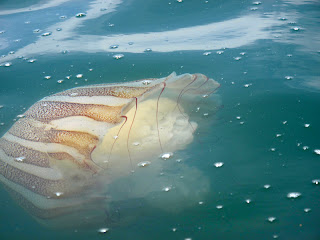Because Valerie now works for an agriculture for development organization, she has learned a lot about sustainable agriculture and the incredibly complex processes involved in receiving international certifications for quality, including organic production. Seeing the fields and hearing about all the steps involved in certified cotton products was especially interesting. Plus, we got to meet a farmer, whose family is deeply engaged in sustainable production and social causes. They are originally from the highlands of Cajamarca (northern Andean region of Peru), where their farmland was appropriated by the military government in the 1970s. Still devoted to that area they do things like provide free breakfasts to local schoolchildren. But they also have explored other regions of the country, like land around Pisco, where they could move into new crops and activities.
The organic cotton seed comes from the northern coast of Peru. And the suppliers did not believe that this family would be able to grow the organic variety in the south. But grow it they do. The plants were in flower while we visited, with fragile yellow and red flowers that only last for a few days.
The trip was also a chance for us to enjoy one of our favorite parts of Peru, the coastal area and national reserve around Paracas. It's a wonderful weekend getaway for those of us living in Lima. The desert colors are spectacular and ever changing. You can count on seeing sunshine, even in the middle of winter. And this time of year (summer) there are all kinds of birds (local and migrating).
We don't know if the cotton in the fields we visited will end up in the clothes you can order from Vieandsomn. But either way, we highly recommend both!
The two guys on the right are beating the odds by growing organic cotton in a part of the country where the seed producers didn't think it would work.
Blue sky, sandy soil, and cotton plants full of flowers
Kayaking in Paracas with blue skies and lots of birds
Flamingos taking flight as we approach in our kayaks.
The Peruvian flag, red and white striped, is said to have been inspired by the colors of the flamingos.
This was the first of numerous giant jelly fish we encountered. We were glad to be in kayaks rather than swimming. This one was over a meter long with huge tentacles.
Another jelly fish with shorter tentacles than the first, but still nasty looking and imposing.
This photo was taken in the Paracas reserve in the late afternoon after the fog rolled in. We were overlooking the rock formation known as the Cathedral. It was totally masked by the fog, and the point looked like the end of the earth.
Watching the fog roll in.
A spectacular sunset inspired rock album poses.
More sunset and feeling of being on the edge of the world.
On our way to the Islas Ballestas, known as the Peruvian version of the Galapagos Islands. The comparison is generous, but you do get to see thousands of birds, including penguins, rare red-footed cormorants, Nasca boobies, even some blue-footed boobies, and lots of sea lions.
The Candalabra petroglyph on the coast. Its age and purpose are unclear, and it is impressive for the way it remains clearly etched in the landscape despite shifting sands and winds.
Islas Ballestas archway filled with sea lions.



















No comments:
Post a Comment